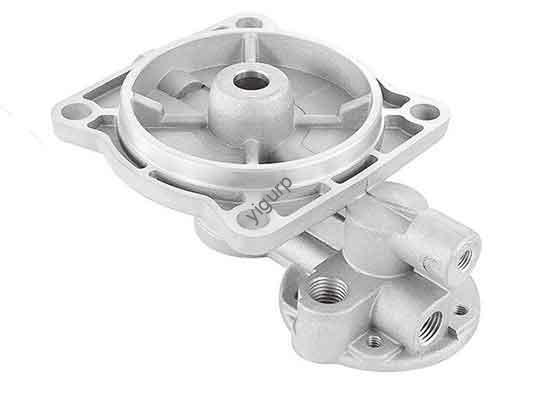If you’re developing prototypes or small-batch parts in Singapore, colocación de aspiradoras (also called urethane casting) es un cambio de juego. It uses a vacuum to draw liquid resin into silicone molds, creating high-precision parts that mimic production-grade materials—faster and cheaper than injection molding. For local businesses, it cuts R&D time by up to 50% and slashes tooling costs to 20-30% of traditional methods . Si estás en automotriz, electrónica, o dispositivos médicos, it bridges the gap between prototypes and market-ready products.
How Vacuum Casting Works: Un desglose paso a paso
The process is straightforward but requires precision—here’s how Singaporean manufacturers execute it:
- Creación de patrones maestros
Primero, a master model of your part is made using 3D impresión o Mecanizado CNC. Singaporean shops like RP World often use 3D printing for complex designs, ensuring the master matches your CAD file exactly . The master is inspected for flaws before moving forward.
- Fabricación de moho de silicona
The master is submerged in liquid silicone, which cures around it (típicamente 24-48 horas). Once set, the mold is cut into two halves, and the master is removed—leaving a cavity that mirrors your part. These molds last 10-20 usos, Dependiendo de la complejidad .
- Colocación de aspiradoras & Curación
Resina (P.EJ., poliuretano) is poured into the mold, which is then placed in a vacuum chamber to eliminate air bubbles (critical for clear or detailed parts). The mold goes into an oven for 3-4 hours of constant-temperature curing . Finalmente, El molde se abre, and the part gets post-processed (cuadro, marcado con láser, etc.).
Ejemplo de caso: A global automation firm in Singapore struggled with CNC-machined impeller assemblies that failed underwater tests. RP World switched to vacuum casting: they 3D-printed a master, made a silicone mold, and cast parts that passed long-term underwater trials—cutting production time by half and becoming the client’s long-term supplier .
Key Advantages of Vacuum Casting for Singapore Businesses
Why choose this over 3D printing or injection molding? Here’s how it benefits local teams:
- Velocidad: Get 20 parte 15 days or less —ideal for tight R&D deadlines.
- Eficiencia de rentabilidad: Silicone molds cost far less than steel/aluminum injection molds. Para 100 regiones, vacuum casting saves 30-60% VS. moldura de inyección .
- Calidad: Parts have superior surface finish (smoother than injection molding) and capture fine details like textures or undercuts .
- Flexibilidad: Usar 11+ resin types (P.EJ., heat-resistant for automotive, transparent for lenses) and add post-processing like screen printing.
Top Materials for Vacuum Casting in Singapore
Singaporean suppliers offer a wide range of resins to match your part’s needs. Here’s a quick guide:
| Tipo de material | Propiedades clave | Usos comunes |
| Hei-Cast PU 8150 | ABS-like rigidity | Gabinetes, casos |
| Axson PX 5212 | Transparente, alta claridad | Lentes, cubiertas de exhibición |
| Hei-Cast 8752 | Flexible (de goma) | Juntas, wearables |
| High-Temp Resins | Resistencia al calor (hasta 200 ° C) | Piezas de motor automotriz |
Para la punta: Jucheng Precision, a Singapore-certified (ISO 9001, Iatf 16949) shop, recommends Hei-Cast 8400 for parts needing both strength and impact resistance .
2025 Trends Shaping Vacuum Casting in Singapore
The industry is evolving fast—here’s what local businesses need to know:
- Automatización & 24/7 Producción
Shops like SM Metal Solutions are adding automated mold prep and part extraction, reducing human error and enabling round-the-clock production . This boosts output by 30% while cutting labor costs.
- AI-Powered Optimization
AI systems now analyze casting cycles to predict mold maintenance and reduce waste. Por ejemplo, AI can spot resin flow issues early, asegurando 99% of parts meet quality standards —critical for medical device makers.
- Eco-Friendly Resins
With Singapore’s strict sustainability rules, suppliers are adopting recyclable resins that cut waste to 5-10% (VS. 20-30% for CNC machining) . Look for shops using bio-based polyurethanes.
How to Calculate Vacuum Casting Costs in Singapore
Costs depend on four factors—use this breakdown to budget:
- Material (40-60% of total cost): PU resins cost SGD 20-50 por kg; high-temp resins go up to SGD 80/kg .
- Mold Fees: A small mold (10x10cm) costs SGD 300-500; large/complex molds reach SGD 1,500 .
- Volumen: Unit costs drop 40% when producing 100 VS. 10 regiones (spreads mold costs).
- Postprocesamiento: Painting adds SGD 5-15 por parte; laser marking is SGD 2-8 por parte .
Ejemplo: 50 ABS-like parts (10x5cm) con pintura: ~SGD 1,800 total (moho: SGD 400, material: SGD 800, labor/post-processing: SGD 600).
La perspectiva de la tecnología de Yigu
“Vacuum casting is the unsung hero of Singapore’s manufacturing ecosystem. We’ve seen clients cut R&D timelines by 60% using this method—especially in electronics, where fast prototyping wins markets. The key is partnering with shops that combine ISO certifications with AI tools: they deliver consistent quality while keeping costs low. As sustainability rules tighten, we’re advising clients to prioritize eco-resins—they don’t just meet regulations but also appeal to green-conscious buyers. Para lotes pequeños (10-500 regiones), vacuum casting beats injection molding every time.”
Preguntas frecuentes: Vacuum Casting Singapore
q: How long does vacuum casting take in Singapore?
A: 7-10 Días para piezas simples; diseños complejos (con postprocesamiento) llevar 12-15 días .
q: Can vacuum casting make metal parts?
A: No—stick to plastics/rubbers. Para metales, Singaporean shops use die casting (P.EJ., SM Metal Solutions) .
q: Is vacuum casting better than 3D printing?
A: For functional prototypes or small batches, yes—parts have better material strength and surface finish . 3D printing is better for 1-5 regiones.
q: Which industries use vacuum casting most in Singapore?
A: Automotor (impellers, alojamiento), Electrónica de consumo (fundas telefónicas, wearables), y médico (device enclosures) .
